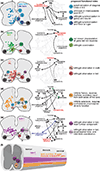Distinguishing subtypes of spinal locomotor neurons to inform circuit function and dysfunction
- PMID: 37611531
- PMCID: PMC10578609
- DOI: 10.1016/j.conb.2023.102763
Distinguishing subtypes of spinal locomotor neurons to inform circuit function and dysfunction
Abstract
Locomotion is a complex motor task executed by spinal neurons. Given the diversity of spinal cord neurons, linking neuronal cell type to function is a challenge. Molecular identification of broad spinal interneuronal classes provided a great advance. Recent studies have used other classifiers, including location, electrophysiological properties, and connectivity, in addition to gene profiling, to narrow the acuity with which groups of neurons can be related to specific functions. However, there are also functional populations without a clear identifier, as exemplified by rhythm generating neurons. Other considerations, including experience or plasticity, add a layer of complexity to the definition of functional subpopulations of spinal neurons, but spinal cord injury may provide insight.
Keywords: Central pattern generator; Interneuron; Locomotion; Rhythm generation; Spinal cord injury.
Copyright © 2023 Elsevier Ltd. All rights reserved.
Conflict of interest statement
Declaration of competing interest The authors declare that they have no known competing financial interests or personal relationships that could have appeared to influence the work reported in this paper.
Figures



References
-
- Grillner S, El Manira A: Current Principles of Motor Control, with Special Reference to Vertebrate Locomotion. Physiol Rev 2020, 100:271–320. - PubMed
-
- Talpalar AE, Bouvier J, Borgius L, Fortin G, Pierani A, Kiehn O: Dual-mode operation of neuronal networks involved in left-right alternation. Nature 2013, 500:85–88. - PubMed
Publication types
MeSH terms
Grants and funding
LinkOut - more resources
Full Text Sources
Medical

